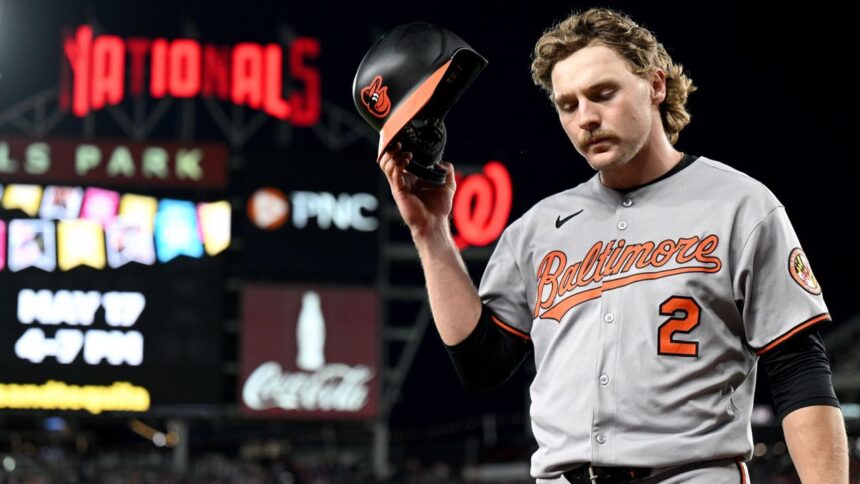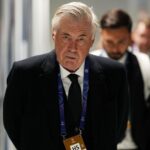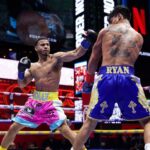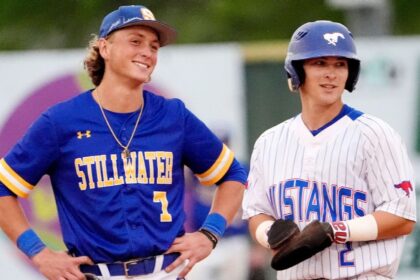Orioles at the Crossroads: What’s Happening in Baltimore?
It’s important to be clear: we haven’t buried the Baltimore Orioles yet. The season is young, and there’s plenty of time for the team to recover and get back in the playoff race. The American League East doesn’t have a clear dominator, and the playoff format with six teams per league makes it easier to access the postseason.
However, the Orioles were expected to be at their best, competing to be the best team in baseball, not battling the Chicago White Sox and the Los Angeles Angels for the worst record in the American League, as is currently the case.
The Orioles had ESPN’s top-ranked farm system in 2022 and 2023, which allowed them to achieve an impressive 101-win season and the division title in 2023. Again, they had the top-ranked farm system entering 2024, and although last year’s 91-win season was a slight disappointment, it at least resulted in another playoff appearance. In each of those years, they had the number one prospect: Adley Rutschman (2022), Gunnar Henderson (2023), and Jackson Holliday (2024). For the 2025 campaign, their farm system fell to number 14, as many of their top prospects already graduated to the Major Leagues.
Baltimore also had another reason for optimism in new owner David Rubenstein, a Baltimore native and fervent Orioles fan, with an estimated net worth of $3.7 billion. Fans hoped he could lead the team to a higher payroll class as the franchise sought its first World Series appearance and championship since 1983.
Instead, the Orioles have a 13-21 record, with a rotation that ranks last in the American League with a 5.75 ERA, ahead of only the Colorado Rockies and Miami Marlins overall, and an offense that is tied for 21st in the majors in OPS and ranks 23rd in runs per game. After averaging 4.98 runs per game in 2023 and 4.85 in 2024, the Orioles are averaging just 3.82 in 2025 (even after the left field fence was moved in at Camden Yards). One game in late April featured a lineup with Ramon Laureano batting first, Ramon Urias batting fourth, and Gary Sanchez and Dylan Carlson batting fifth and sixth. This was not how this was supposed to look.
What happened here? Would it be unusual for a team to be where the Orioles were and suddenly fall apart? To investigate this, we found teams that matched the Orioles’ situation entering 2024: coming off a playoff season and also possessing a top-tier farm system the following spring. That would seem to be the perfect storm for a very high competition window: a good team with more young talent on the way.
Going back to the year 2000, we find all the teams that (1) had reached the playoffs and (2) started the following season with a farm system ranked in the top three, according to Baseball America (since 2001) or ESPN (since 2012). Including the 2023 Orioles, this provided a list of 25 teams. We then tracked the performance of each team over the next three seasons; for the 2023 Orioles, this would include only the 2024 season so far.
These are those 25 teams, as well as their records in the following three seasons:
Our overall findings: these teams not only performed exceptionally well, but were rarely bad, and often excellent.
Of 71 future seasons that have been completed in each team’s immediate three-year window, these teams made the playoffs 48 times, 68% of the time, including the Orioles in 2024. Those odds have been even greater in recent seasons with the expanded playoff field; the first three teams on the list (the 2000 White Sox, the 2001 Seattle Mariners, and the 2001 Houston Astros) made only one playoff appearance in nine seasons between them.
There were only eight losing seasons out of 71. Excluding 2020, 42 teams out of a possible 67 seasons won at least 90 games (63%), and 14 (21%) won at least 100.
Let’s delve into and compare the 2023 Orioles, and their subsequent three-year window of contention, more specifically with the five teams in our study that had a farm system ranked No. 1.
Chicago White Sox (2000) (95-67)
Top five prospects in 2001: Jon Rauch, Joe Borchard, Joe Crede, Matt Ginter, Dan Wright
Other notables: Aaron Rowand
Following three seasons: 83-79, 81-81, 86-76 (no playoff appearances)
This is an interesting team because another element of the perfect storm for competition would be the younger the playoff team, the better. Combining the average age of the position player group and pitchers from Baseball-Reference (which adjusts those figures by playing time), the White Sox were the second youngest team on the list, behind only the 2022 Cleveland Guardians. And yet, Chicago struggled for the next three seasons, and got very little from that group of prospects.
However, the White Sox broke through in 2005, winning the World Series, with Crede and Rowand as starters on that team. Rauch was injured, but was traded for Carl Everett, another starter on the 2005 team.
How the Orioles Compare: The 2023 Orioles were one of the youngest teams on the roster, tied for the fifth-youngest. This was a big part of the optimism surrounding them, especially with those top three overall prospects providing the foundation. However, the Orioles were always thinner on pitching prospects, and that has been a problem in 2025, as injuries in the rotation have piled up.
Of course, the expectation this past winter was that Rubenstein and general manager Mike Elias could go after a top-tier starting pitcher, similar to the previous offseason, when Elias traded two prospects for a legitimate ace in Corbin Burnes. The Orioles then acquired Zach Eflin during the season. But Burnes was only a one-year rental and signed with the Arizona Diamondbacks, while Eflin is currently out with a lat strain. Young right-hander Grayson Rodriguez has been out all season with an elbow issue, and Kyle Bradish, the team’s primary starter in 2023, is still recovering from Tommy John surgery.
The problem hasn’t just been the injuries, but the plugs: Charlie Morton, 41, is 0-6 with an ERA of 9.76, Kyle Gibson, 37, is 0-1 with an ERA of 14.09 in two starts, and Cade Povich is 1-2 with an ERA of 5.16.
St. Louis Cardinals (2012) (88-74)
Top five prospects in 2013: Oscar Taveras, Shelby Miller, Carlos Martinez, Trevor Rosenthal, Kolten Wong
Other notables: Michael Wacha, Tommy Pham
Next three seasons: 97-65, 90-72, 100-62 (three playoff appearances)
The Cardinals reached the World Series in 2013 (losing to the Boston Red Sox) and had the best record in the National League in 2015 before losing to the Chicago Cubs in the divisional series. The group of prospects helped complement what had been more of a veteran team in 2012. Miller joined the rotation in 2013 and won 25 games in two seasons and was then traded to the Atlanta Braves for Jason Heyward. Martinez spent a year in the bullpen and became an All-Star starter in 2015 and 2017. Rosenthal accumulated 93 saves in 2014-15. Wong was a solid starter, and Wacha was the playoff hero in 2013. Taveras, the star prospect of the group, died in a car accident after the 2014 season.
How the Orioles Compare: The Cardinals were built from 2012 to 2015 around their starting rotation: Adam Wainwright, Lance Lynn, Wacha, Miller, and Martinez. When Wainwright was injured in 2015, they still had the depth to compensate. They signed John Lackey, and he went 13-10 with 5.8 WAR and a 2.77 ERA in 2015. Miller was used to acquire Heyward, who recorded 7.0 WAR in 2015 (though he later left as a free agent).
In other words, it was a completely different philosophy than the one Baltimore is using. The Cardinals believed they could fill the voids on the position player side, and they did so until 2015. (Although once Yadier Molina and Matt Holliday declined, they didn’t make the playoffs for three consecutive years starting in 2016).
The Orioles are following the example of the Cubs and Astros, who built World Series winners in 2016 and 2017 around a core of position players. The Cubs complemented that group with free agent signings Jon Lester and Lackey, in addition to two shrewd trades for Jake Arrieta and Kyle Hendricks. The Astros traded for Justin Verlander, Gerrit Cole, and Zack Greinke to help build their dynasty.
Elias was part of that main Houston office, and although the Burnes trade worked out for his only season in Baltimore and Eflin pitched well last season after the trade (2.60 ERA in nine starts), it’s fair to say that Elias hasn’t landed a starter with the multi-year impact of a Lester, Hendricks, Verlander or Cole.
Pittsburgh Pirates (2013) (94-68)
Top five prospects in 2014: Gregory Polanco, Jameson Taillon, Tyler Glasnow, Austin Meadows, Nick Kingham
Other notables: Josh Bell, Clay Holmes, Adam Frazier
Following three seasons: 88-74, 98-64, 78-84 (two playoff appearances)
The Pirates had a strong three-year window from 2013 to 2015 with three consecutive postseason trips, but have only had one winning season since then. It wasn’t so much a lack of willingness to spend on the payroll, but a series of bad trades and prospects that didn’t pan out. Polanco just wasn’t that good. They traded Gerrit Cole and didn’t get enough in return. They traded Glasnow, Meadows, and Shane Baz to the Tampa Bay Rays in the unfortunate 2018 Chris Archer trade.
How the Orioles compare: We’re still figuring out if this will be the case with some of these Orioles prospects. But the other thing that happened to the Pirates is that Andrew McCutchen, their superstar during those three playoff seasons (averaged 6.4 WAR and was the MVP winner in 2013), didn’t keep going. He fell to minus-0.4 WAR in 2016 and 3.1 WAR in 2017 and was then traded in 2018. Starling Marte averaged 4.8 WAR during the playoff run, but had a performance-enhancing drug suspension in 2017 and wasn’t as good when he returned. Even Cole was worth only 1.5 WAR in 2016 and 2.6 in 2017 before exploding after his trade to Houston.
In other words, the Orioles need their stars to perform, and Henderson and Rutschman haven’t done so so far in 2025. Henderson has only five RBIs in 27 games, and Rutschman is batting .211/.318/.351. Jordan Westburg, an All-Star in 2024, is batting .217/.265/.391 and is currently on the injured list with a hamstring strain. Colton Cowser, last year’s Rookie of the Year runner-up, played only four games before fracturing his left thumb.
In any case, this is the reason why we probably don’t want to give up on the Orioles: they have gotten very little from a group that should be doing much more. (And those players are younger than McCutchen and Marte, so there’s no reason why they should collectively perform so poorly).
Los Angeles Dodgers (2015) (92-70)
Top five prospects in 2016: Corey Seager, Julio Urias, Jose De Leon, Jose Peraza, Cody Bellinger
Other notables: Alex Verdugo, Walker Buehler
Following three seasons: 91-71, 104-58, 106-56 (three playoff appearances)
The 2015 Dodgers were built around Clayton Kershaw and Greinke, who combined for a 35-10 record with a 1.90 ERA. Their best position players were 33-year-old Adrian Gonzalez and 30-year-old Justin Turner. While they didn’t win a World Series in the following three years, they did reach the World Series twice in that span, and finally won the Series in the shortened 2020 season, with Seager, Urias, Bellinger, and Buehler playing vital roles (while Verdugo became the key player in the trade for Mookie Betts).
How the Orioles Compare: The 2023 Orioles were a much younger team than the 2015 Dodgers. (Most of Los Angeles’ regular position players were over 30; they had the oldest position player group in the National League that year.) Therefore, there isn’t much in common here. Yes, the Orioles have their version of Seager in Henderson, but do they have a Bellinger in the making? Can Bradish and Rodriguez recover from injuries and help win a World Series, as Urias and Buehler eventually did? The Dodgers used the depth of their farm system to eventually trade for Betts and then signed him to a long-term contract. While the Orioles have shown a willingness to make an impact trade (Burnes), they have, of course, shown no inclination to spend that kind of money.
The Dodgers have also been able to keep prospects on track: ESPN’s Kiley McDaniel ranked the Dodgers as the No. 1 farm system entering 2025, a notable assessment given how they draft each year. Even when the Orioles’ farm system ranked first in 2024, it was more about the quality at the top (Holliday, Coby Mayo, Samuel Basallo, and Heston Kjerstad leading the way) than overall depth.
Tampa Bay Rays (2019) (96-66)
Top five prospects in 2020: Wander Franco, Brendan McKay, Matthew Liberatore, Vidal Brujan, Shane Baz
Other notables: Shane McClanahan, Xavier Edwards, Joe Ryan, Josh Lowe, Taj Bradley, Pete Fairbanks
Following three seasons: 40-20, 100-62, 86-76 (three playoff appearances)
The Rays reached the World Series in 2020, had another great season in 2021, earned a wild card spot in 2022, returned to the playoffs with 99 wins in 2023, and finally stumbled in 2024, finishing 80-82. The 2019 Rays were a young team, tied for the third youngest on our list. While that top group of prospects didn’t do much with Tampa, only Baz is still active with the organization, the Rays had so much depth in their system that they still managed to extract a lot of value. (Although they’d probably like to redo the Ryan trade for Nelson Cruz in 2021).
How the Orioles Compare: The 2019 Rays would be the best direct match for the 2023 Orioles in terms of youth, roster composition, and timeline. Those Rays were the culmination of a multi-year rebuilding project, just like the 2023 Orioles. Tampa Bay made five straight playoff appearances, the kind of results you’d expect from a young team with a high-rated farm system. (And the results might have been even better if it weren’t for Franco’s off-field issues).
One thing the Rays aren’t afraid to do: trade their prospects. Liberatore went to the Cardinals for Randy Arozarena; Edwards went to the Marlins for Santiago Suárez, an intriguing pitching prospect now in High-A; and Brujan brought Jake Mangum, who is contributing to the Rays in 2025. Not all of their trades have worked, but many have.
So far, the Orioles have mainly held onto their guys. The Trevor Rogers trade with the Marlins last summer doesn’t look good right now. Rogers was bad after the trade, and is now injured, while Kyle Stowers could be having a breakout season for Miami. Kjerstad is struggling for the Orioles, and Mayo was just called up after hitting 4-41 with 22 strikeouts in a big league test last year. There’s a chance neither develops as hoped.
Given the mostly successful history of the teams in the studio, is there a worse scenario for the Orioles? Here are three examples.
Seattle Mariners (2001) (116-46)
Farm system classification: No. 2
Top five prospects: Ryan Anderson, Rafael Soriano, Antonio Pérez, Chris Snelling, Clint Nageotte
What went wrong: The Mariners won 93 games in each of the next two seasons, although they didn’t make the playoffs at a time when only four teams did. Then they collapsed to 63-99 in 2004. They were the oldest team in our study, with an average age of 31.1 years. Therefore, that group aged after a couple of years, and the prospects didn’t develop, and almost 20 years of bad baseball ensued. Anderson, nicknamed “The Little Unit” due to his physical resemblance to Randy Johnson, was injured and never made it to the majors. Soriano had three 40-save seasons, long after the Mariners traded him. Snelling was a promising Australian outfielder who made it to the majors at age 20 but couldn’t stay healthy. The Mariners also had Shin-Soo Choo in the system and traded him for nothing.
What the Orioles can learn: The Mariners are not a great comparison since they were such a veteran team, but bad trades certainly didn’t help. Carlos Guillen, the starting shortstop in 2001, was traded after 2003 to the Tigers for light hitter Ramon Santiago and became a three-time All-Star with Detroit. When the Mariners faded in 2004, they traded ace Freddy Garcia to the White Sox with a minimal return. Asdrúbal Cabrera signed as an amateur free agent with Seattle in 2002 and was later traded to Cleveland, where he was part of a couple of All-Star teams.
Moral of the story: You have to trade well. The Orioles did it in 2002, when they acquired Povich and Yennier Cano for Jorge López, but they will need more of those wins.
Texas Rangers (2011) (96-66)
Farm system classification: No. 2
Top five prospects: Jurickson Profar, Martin Perez, Mike Olt, Leonys Martin, Neil Ramirez
What went wrong: After losing the 2011 World Series, the Rangers returned to the playoffs in 2012 but then lost a tiebreaker game to miss the playoffs in 2013. They fell to 67-95 in 2014 before making a couple of soft playoff appearances in 2015 and 2016. Thus, this was not a large-scale disaster, although they have only had one winning season since 2016; that was in 2023, and it resulted in a World Series title.
This was a case where the prospects just weren’t as good as advertised. Profar was the No. 1 prospect in the game, but shoulder injuries derailed his career. Perez is still pitching, but didn’t become a big star. Olt was a power-hitting third baseman traded with Ramirez to the Cubs in 2013 for Matt Garza, a rental pitcher. The Rangers also traded Hendricks to the Cubs for another rental in Ryan Dempster, while Martin, Rougned Odor, and Nomar Mazara never had the plate discipline to become consistent hitters in the majors.
What the Orioles can learn: Don’t overestimate your own prospects, or at least make sure you evaluate them accurately. The Rangers let productive veterans like Cruz, C.J. Wilson, and Mike Napoli (plus Josh Hamilton, although his career fizzled out after leaving the Rangers) walk in free agency because they believed they had prospects ready to step in. They traded Ian Kinsler for Prince Fielder with the idea that Profar could take over at second, but that turned into a difficult trade when Fielder had to retire due to a neck injury. They also had bad luck with injuries in the rotation with Matt Harrison, Derek Holland, and Alexi Ogando, all injured.
The Orioles will face many similar types of decisions this offseason, with a large portion of the roster heading to free agency, including Cedric Mullins, Eflin, Ryan O’Hearn, and Gregory Soto, in addition to several other players on one-year contracts. The owner’s checkbook might have to play a bigger role next offseason.
Boston Red Sox (2013) (97-65)
Farm System Ranking: No. 2 Baseball America/No. 5 ESPN
Top five prospects: Xander Bogaerts, Henry Owens, Jackie Bradley Jr., Allen Webster, Blake Swihart
Others on the system: Mookie Betts, Rafael Devers, Christian Vazquez, Matt Barnes, Manuel Margot, Brock Holt (and a bunch of others who made the playoffs)
What went wrong: This isn’t even a worst-case scenario, necessarily, although the Red Sox were the only team on our list to have two losing seasons out of the next three. (The 2022 Guardians could match that with a losing record in 2025.) Boston won the World Series with an older team in 2013, but was below .500 in 2014 and 2015. Eventually, the farm system produced another World Series title in 2018.
What the Orioles can learn: The 2013 Red Sox had David Ortiz, Dustin Pedroia, and some other veterans who had great years. By 2018, Ortiz had retired and Pedroia was injured. But Boston had created new stars: Betts, Bogaerts, and Chris Sale (acquired for prospects Yoan Moncada








